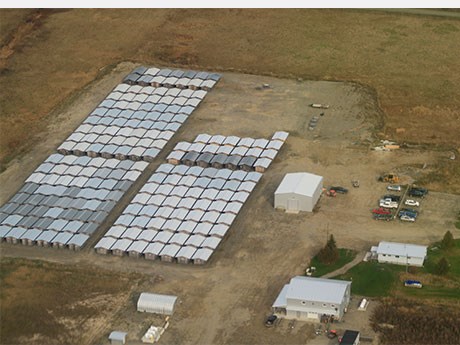Annual production of 325,000 ounces of gold and 480,000 ounces of silver
Gold was worth a little more than $400 an ounce in December 2004 when geologist Nelson Baker had lunch in Vancouver with a merchant banker looking for a potentially promising exploration project to fund.
“If you had all the money you wanted to set up a company,” Baker was asked, “would you know of a good gold property to acquire?”
Baker’s experience across Canada gave him a good overview of promising gold properties and the one that immediately came to mind was the Rainy River project in northwestern Ontario.
He had checked out the Rainy River property, 65 kilometres northwest of Fort Frances, in 1999 when he worked for Hunter Dickenson, but the owner of the property, Nuinsco Resources, balked at Hunter Dickenson’s terms.
Baker made an appointment to see Nuinsco president Warren Holmes and talked him into parting with the property in return for $2.5 million in cash and 2.4 million shares in Rainy River Resources.
A few months short of a decade later, the property was acquired by Vancouverbased New Gold as part of a $310 million cash and share deal, and is scheduled to begin full production in 2017.
“It speaks to the length of the development cycle in the mining industry,” said Grant Goddard, general manager for New Gold’s Rainy River project.
“Nuinsco did a lot of work from 1993 to 2004, and Rainy River Resources took it all the way to through to an environmental assessment.”
The development-ready project acquired by New Gold boasts proven and probable reserves of 104 million tonnes grading 1.13 g/t gold and 2.81 g/t silver for 3.8 million contained ounces of gold and 9.4 million ounces of silver.
The surface and underground operation will process ore at a rate of 21,000 tonnes per day for annual production during the first decade of approximately 325,000 ounces of gold and 480,000 ounces of silver.
Rainy River, which has a 14-year mine life, received final federal government approval of the project’s environmental assessment January 13th and hoped to gear up for site preparation in February by which time it expected to have all of its required permits in hand.
Long lead time capital equipment has already been ordered and will arrive on site as construction ramps up through 2015 and 2016. The surface fleet will include 22 Komatsu haul trucks, three Sandvik blast hole drills and two hydraulic shovels.
The pit will be 1.5 kilometres long in an east-west direction by one to 1.5 kilometres in a north-south orientation with 25 benches down to a depth of 200 metres.
The mill will use conventional carbon in pulp extraction technology and feature a gyratory crusher up front, as well as a 36-foot SAG mill and a 26-foot ball mill. The total budgeted capital cost for Rainy River is $885 million.
An intermediate gold producer, the company currently has four operating mines – the New Afton copper-gold mine in British Columbia, the Mesquite gold mine in California, the Peak goldcopper mine in Australia and the Cerro San Pedro gold-silver mine in Mexico.
Rainy River made sense for New Gold because of its location, its proximity to established infrastructure and the availability of a skilled workforce.
“It’s not Nunavut, Northern Saskatchewan, northern British Columbia or Labrador – all of which I’ve worked in,” said Goddard.
It has year-round road access and powerlines in close proximity, as well as a railway 21 kilometres south of the property. Nearby Fort Frances, a town of 10,000 that has been impacted by the downturn in the forest products industry, will serve as a source of skilled labour.
New Gold also boasts excellent relations with the First Nations in the area. Approximately 500 workers will be onsite during the peak of construction and between 400 and 450 workers will be required during the initial phase of production, growing to 600 in 2018 when underground operations commence via a four-kilometre ramp.
The community has been very supportive – not only because of the jobs the company is bringing to the area, but also because of the way New Gold operates, said Goddard.
“We’ll be here for 14 years, maybe more if we find some more ounces, but we will be gone from here at some point in time. Our job is to provide a good return to our shareholders and do all the things we’ve committed to in our EA, but more importantly, when we leave, we want people to look back and say, ‘We’re glad New Gold was here. They did a good job. They contributed to the community.’”
Gold prices have been on a roller coaster ride since Nelson Baker’s fateful lunch in Vancouver, skyrocketing from $400 in 2004 to $1,900 in 2011 and, more recently, retreating to the $1,200 range, but Goddard isn’t particularly worried.
“One of the positive things about New Gold is that we have one of the lowest all-in unit costs (in the gold mining industry),” he said. “We focus every day on sustainable long-term low unit costs for our production, so we’re not as impacted as other companies.”


